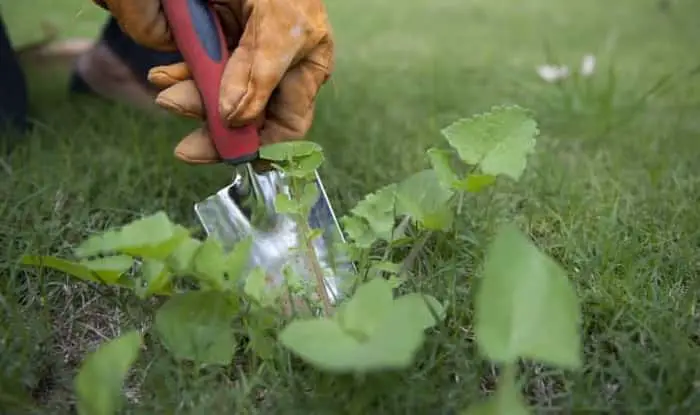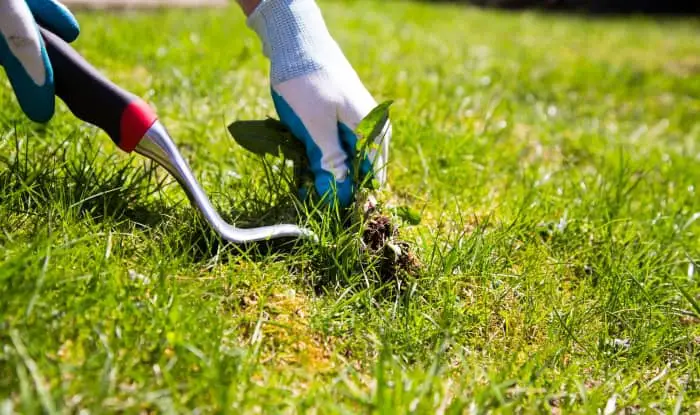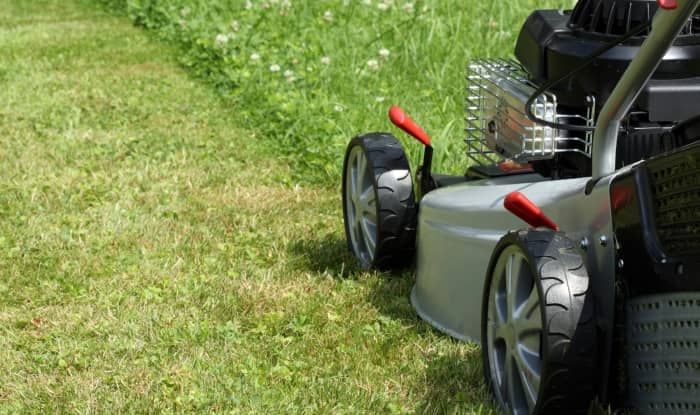Keeping weeds under control is essential if you want that perfect lush, green lawn.
And it really comes down to 2 choices:
Doing it by hand the natural way. Or using weed killer. They both have their pros and cons.
We’ll take a closer look at these, and I’ll show you how to get the job done.
And don’t forget that keeping your lawn growing healthy and strong makes it harder for weeds to grow and spread. We’ll cover the key things to take care of to keep them away.
So let’s get started, and take a closer look at how to get rid of a lawn full of weeds.
How To Get Rid Of A Lawn Full Of Weeds
Before you start, it’s a good idea to identify the weeds growing in your lawn. Once you know what you’re dealing with, it’s easier to select the best approach for weed removal.
Both natural and chemical methods of weed control have pros and cons and are simple to do. And they can both be effective when done in the right way.
Using A Lawn Weed Killer
If you have a lot of weeds to get rid of, then using the best weed killer for lawns is the most effective method of control.
Lawn herbicides are selective. This means they target weeds without killing common types of turfgrass. They’re formulated to be effective at killing:
- Broadleaf weeds — such as dandelion, clover, and chickweed
- Grassy weeds — such as foxtail, quackgrass, and crabgrass
- Grass-like weeds — such as nutsedge, wild onion, and wild garlic
But you still have to be careful when using them. Not all products are safe to use on all grass types. So check first to make sure your grass is recommended. And make sure the product you choose is labelled for use on the weed types growing on your lawn.
Also, stay away from non-selective weed killers containing ingredients such as glyphosate. These kill all vegetation, including your grass.
Herbicides are easy to use. Just mix the concentrate with water and add it to a weed-killer sprayer. Then make sure you soak the target weeds as you spray your lawn. The weeds should turn brown and die. But, depending on the herbicide, the time taken can vary.
Systemic weed killers are best for killing the plants to the root and preventing them from growing back. But you have to be patient when using them, as they can take from 2-4 weeks for a complete kill.
After the weeds have died you can use a rake and tilling fork to clear the leftover plant from the soil in preparation for reseeding the area or laying sod if necessary.
When treating reseeded areas that contain new grass seedlings it’s best to wait at least a month before using chemical weed control so you don’t cause any harm.
Natural Methods for Weed Removal in Your Lawn
If you don’t like the idea of using chemical herbicide on your lawn then here are some natural methods you can try:
Pulling Weeds By Hand
Sometimes, the traditional way is the best. If you only have 1 or 2 plants to remove, then weeding by hand is usually quick and effective.
Use a trowel to dig down around the plant and remove it from the ground. Make sure you take the roots as well.
If you want to make the job easier, you can use a weed puller. This tool allows you to stand as you pull the weeds out of the ground.
The main drawback of removing them by hand is that it takes a lot of hard work if you have a lawn full of weeds.
And because some lawn weeds grow back quickly if you leave any of the root system behind, it can be difficult to completely get rid of them without taking great care.
A common problem weed that’s very difficult to control by hand once it’s well established in your yard is nutsedge.
Vinegar
Another natural method that people often recommend is vinegar. This burns the weed on contact, killing every part it touches. Pour it into a handheld sprayer and then apply it to all visible parts of the plant.
You’ll have to use a strong acetic acid solution of somewhere between 10-20% concentration. Normal table vinegar isn’t usually powerful enough for the job.
But there are two problems with using vinegar.
Firstly, it kills the plant above the ground. And because it doesn’t make contact with the roots the weed will sometimes regrow. This means you might have to repeat the treatment.
And even more importantly, vinegar is a non-selective weed killer. It kills all plants that you spray it on. This means it will also burn your grass. So you have to be very careful when using it on your lawn. For many people, this makes it impractical.
Lawn Care & Maintenance
If you don’t take good care of your turf, it’s not unusual to see weeds take over your entire lawn.
The most important thing you can do to keep weeds out of your lawn is to make sure it grows in perfect health.
A thick, lush lawn leaves less opportunity for weeds to establish themselves. And crowds out any that start to grow.
Here are some lawn maintenance tips that help to keep weeds away:
Mowing
Keep the blades on your mower on a high setting as you go over your lawn. This allows your grass to grow longer.
It can cure weed issues because it’s harder for them to invade lawns covered with long, thick grass.
Fertilizer
Is your lawn thin and patchy in places?
If so, it’s an ideal opportunity for weed seeds to germinate and grow.
Your grass will grow better if you feed it the nutrients it needs. Consider using an NPK fertilizer (Nitrogen-Phosphorus-Potassium) to encourage better growth. Or use an organic fertilizer for lawns.
You can also get weed and feed products. These combine fertilizer and weed killer in easy-to-apply granules that you can spread on your lawn using a broadcast spreader.
Plant New Grass Seed
In areas of your lawn that are bare, sow some new grass seed.
- First, make sure you’ve removed weeds, moss, and other debris from the area
- Then rake the soil to loosen it
- Scatter the seeds using your hands or a handheld spreader
- Finally, use your foot or a roller over the newly seeded area to press the seeds into the soil.
When overseeding your lawn, try sowing the seeds at 35g per m2.
Watering
It’s important to keep your lawn well-watered so the grass can grow in good health.
But, too much of a good thing can be a problem that allows the weeds in.
Watch how well your soil drains and how long it remains moist. Why?
Because wet and soggy conditions provide the ideal breeding ground for some of the most common and problematic weeds, such as nutsedge and crabgrass.
Watering on a daily basis helps to keep soil moisture levels high. So, if you find yourself struggling with weeds that like wet soil consider changing to a routine of deeper watering one or two times per week.
Lawns usually require around 1.5 inches of water each week. But this varies depending on the type of soil you have and the climate.
If your lawn doesn’t drain well and is becoming overgrown with weeds you can fix the problem by improving aeration.
Aeration
Aeration helps your turfgrass grow stronger. By reducing soil compaction and providing spaces that extend into the soil it has many benefits, including:
- Better water penetration and root uptake
- Improved fertilizer uptake
- More oxygen in the soil
- Deeper and stronger root growth
You can aerate your lawn using garden tools, such as a lawn aerator.
Final Thoughts
You can renovate lawns full of weeds to their ideal condition with careful management and a strategy to remove weeds.
If you’re looking for how to get rid of weeds naturally without killing grass then you’ll have to do it by hand. But this can be tough work if you have lots of grass weeds to get rid of.
If you don’t mind using a chemical herbicide then you can make the job a lot quicker and easier. But make sure it’s a selective weed killer so you kill weeds, not grass.
Another good method to prevent yard weeds from growing in the first place is to use a pre-emergent herbicide.
When applied to your lawn at the right time of year — usually early spring and late summer/early fall — a pre-emergent can stop annual weeds like crabgrass from germinating.
But to eliminate perennial weeds, you’ll either need to remove the plant, roots and all, or use a post-emergent herbicide.
Do you have any other ideas about how to get rid of a lawn full of weeds? Let us know in the comments.




Your comments on weed killers are informative and useful.
But, what is not considered is that it rains seriously on a daily basis in some part of the regions in England. The soil remains wet and soggy for weeks. Nothing anyone can do about nature and have to wait to the to properly dry before mowing.
I cannot mow the grass as I would like to because the weeds grow wild and are uncontrollable damaging my lawn due to the weather.
I have spent a lot money on weeds killers and this can be frustrating especially when I enjoy and love gardening. I like my lawn to remain green and beautiful.
Looking after my garden gives keeps me active and gives me pleasure. Unfortunately no weed killers seem to work. It is a nightmare.
I do not know what solution is but life goes on.
That is a really well done piece. My compliments. One thing that I think should be mentioned is another downside to using a 10-20% concentration of vinegar is that you want to be very careful using it. Particularly don’t rub your eyes or get it in your eyes.